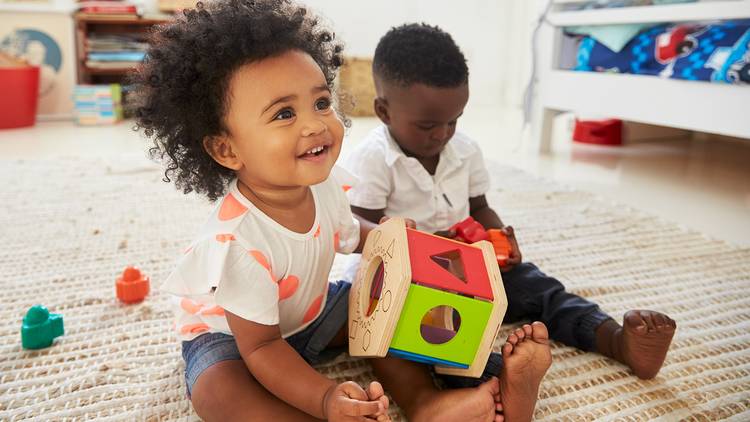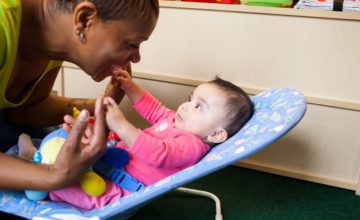Learn about Math4Littles, a set of fun and engaging parent-child math activities.
Why are early math activities important?
Today’s toddlers are tomorrow’s designers, programmers, and engineers. Math education begins by developing a child’s math literacy and building on rapid brain development from birth to five. Robust research shows that math experiences and exposure to math language have strong impacts on children’s emerging and later math skills, both in the first five years and once children enter formal education.1,2 However, there is a growing divide. Families in underserved and under-resourced communities may have fewer options for affordable, high-quality caregiving settings and/or less access to learning environments that offer children enriching, exploratory early math experiences.3
Research shows that the impact of early risk can be lessened by providing children with access to high-quality early learning and preschool experiences.4 Research also indicates that children attending preschool can attain higher levels of understanding in math when they are supported through well-planned, stimulating, and developmentally appropriate activities.5 Just like early language skills, very young children are learning about math concepts through everyday experiences with parents and early educators. Recent research shows a strong correlation between parents’ use of math language in interactions with preschool children, and children’s use of math language and their acquisition of math concepts.6,7,8 As the most influential adults in young children’s lives, it is vitally important to engage parents in children’s early learning. Just as book-sharing supports literacy readiness, age appropriate math activities and math language in the home can nurture children’s math readiness.
What is Math4Littles?

 Math4Littles is a collaboration of the American Institutes for Research and ZERO TO THREE that offers a set of hands-on, no- or low-cost parent-child math activities that are fun, engaging, and provide an age-appropriate introduction to early math concepts. Children under five thrive with a playful approach to math that engages them in exploring a problem.9 However, it can be difficult to understand which math activities are appropriate for young children’s developmental capacities. Math4Littles provides parents with a range of engaging play-based parent-child activities that are aligned to the skills and growing capacities of two- and three-year-olds. These activities are designed to build young children’s early understanding of math concepts across six domains (counting, computation, spatial awareness, shapes, patterns, and measurement). The Math4Littles activities were originally delivered via text message to parents in a study designed to determine whether learning about early math activities would increase parents’ understanding and use of early math play with their children and enhance young children’s early math skill acquisition.
Math4Littles is a collaboration of the American Institutes for Research and ZERO TO THREE that offers a set of hands-on, no- or low-cost parent-child math activities that are fun, engaging, and provide an age-appropriate introduction to early math concepts. Children under five thrive with a playful approach to math that engages them in exploring a problem.9 However, it can be difficult to understand which math activities are appropriate for young children’s developmental capacities. Math4Littles provides parents with a range of engaging play-based parent-child activities that are aligned to the skills and growing capacities of two- and three-year-olds. These activities are designed to build young children’s early understanding of math concepts across six domains (counting, computation, spatial awareness, shapes, patterns, and measurement). The Math4Littles activities were originally delivered via text message to parents in a study designed to determine whether learning about early math activities would increase parents’ understanding and use of early math play with their children and enhance young children’s early math skill acquisition.
The Math4Littles program included two primary components, delivered over the course of 12 weeks:
- Parent Activity Guides: After receiving the text messages, the objective of the program was to spur parent-child play focused on early math skill acquisition. Each text message included a short description of the activity and then a prompt for parents to click through to a webpage with complete instructions for the game.Math4Littles activities include a wide variety of play that young children find engaging, including discovery play (with exposure to early math concepts through movement, rhythm, and music activities) and pretend play (such as comparing two lengths of puppy tails or creating a “train” of big and little shoes).Each activity guide includes suggestions for parent-child play activities that support specific domains of early math skills. The Math4Littles activities are offered in an order that builds upon each preceding week: the program starts with basic concepts (numbers, counting, 1:1 correspondence) and gradually introduces more complex concepts (spatial relationships, patterns, shapes). Activities may also be easily adjusted to reflect children’s individual needs and skill levels. All activities are designed to fit into daily routines, be easy to implement, and require few materials outside of what could be found in a typical family home.
- Online Forum: In the research study, parents in each Math4Littles cohort were also invited to participate in a private group on Facebook to discuss the activities and post any questions they had about the program or their child’s participation. The Facebook group postings were moderated by two child development specialists. Messages posted in the group reflected the content of the text messages, with additional postings that included more suggestions for math-related parent-child play.
What early math skills can 2- and 3-year-old children learn?
It may seem like 2- and 3-year-olds are too young to learn about math, but they’re not! Early math concepts provide children with a strong foundation on which to build new, more complex math skills as they grow. Foundational concepts like number knowledge, understanding more and less, and simple addition/subtraction are accessible for these young children. Age-appropriate exploration into spatial awareness (where an object is in space, in relation to other people and objects), measurement, shapes, and patterns are also precursors to later math skills.
The table below highlights some of the early math concepts that children are beginning to learn and master at age two and beyond. While every child learns at their own pace, these skills include some of the math concepts that often show up in young children’s play. Parents and professionals can use this table as a guide to understand the kinds of play experiences and math language that can support children’s learning as early as age two years.
| Topic | Constructs | Vocabulary |
|---|---|---|
| Number Knowledge (Counting): Correctly determining the number of objects in a collection. |
• Verbal Counting • Subitizing (Ability to immediately recognize the total number of items in a set and label with the correct number word.) • One-to-one Correspondence (matching sets without counting) • Counting Objects |
• more • a lot • number words: one, two, and three |
| Operations (Addition and Subtraction): Changing an existing collection by making it larger or smaller. |
• More and less (relational); ability to compare small collections of 1-3 objects and determine which collections have fewer or more objects • Addition and subtraction |
• more/less • add • taking away • fewer |
| Spatial Awareness: Relative position of objects and people. |
• Understanding that objects have a position and an orientation in space | • on top/under • in front/behind • up / down • around • next to • in/out |
| Shapes: Ability to recognize and name attributes of simple/basic geometric shapes. |
• Recognizing (Identifying) shapes/Naming shapes | • circle triangle, and square • angles • sides • long / short |
| Patterns: Ability to identify and create patterns. |
• Sorting and classifying • Identifying patterns/regularities |
• yesterday / tomorrow • day / night • shape, size, and color words • first, second, last |
| Measurement: Ability to make direct comparisons. |
• Understanding size and other measurable characteristics (comparative) | • Size (big, small, little) • Length (long, short) • Height ( short, tall) • Weight (heavy, light ) • Capacity (full, empty) • Distance (far away or close by) • Similarity (same, different) • Speed (fast, slow) • Temperature (warm, cold) |
How might I implement the Math4Littles program at my organization?
The original Math4Littles program used text messaging to deliver web links to early math activities that parents could use with their children; text messages were supported by parallel messaging in an online forum. Early childhood programs could easily share the Math4Littles activity guides with parents over email (with web links) or in hard copy.
There is also great potential in using the Math4Littles activities as part of the daily routines of a child care program or other early childhood setting, either introducing these activities one-on-one with children, as center activities, or as circle time activities. After introducing these math activities in the program, professionals could share links to the activity guides with parents to build stronger home-school connections in terms of early math learning.
Note: A classroom-based pilot of Math4Littles was not part of the original research study, but including early educators in this program, along with parents, is a promising avenue for future research.
Tips to Support Parent Success with Math4Littles
- Remember that activities can be individualized. Remind parents and caregivers they can gradually decrease or increase the difficulty of the activities to reflect their individual child’s current skills. They can also repeat activities over time to ensure mastery.
- Struggling is okay. Reassure parents that it is quite common for children to struggle with a new concept at first. Explain that the Math4Littles experience is designed to repeat concepts and help children build understanding as it progresses.
- Sharing helps. Prompt parents to share photos or other documentation of Math4Littles activities and share these on bulletin boards in the classroom or via classroom newsletters.
- Find connections. Let parents know they can also pair the Math4Littles activities with other experiences such as reading math-focused children’s stories—as these also nurture early math skills. (See book suggestions here.)
- Celebrate and engage. Host a Math Night to introduce Math4Littles to parents, encourage participation in the program, and give parents and children an opportunity to engage in math-focused games and activities as a community.
What are the expected outcomes of exposing children to Math4Littles activities?
A study of 358 families, half of whom completed the three-month Math4Littles program, found that children whose parents received the early math text messages performed at a higher level on a foundational early math skill called subitizing, or naming the number of objects in a group without explicitly counting. Furthermore, parents who received the Math4Littles activities spontaneously did more math activities with their children during an observed play session. A third important finding was that parents who received the math activities reported stronger beliefs that math is important for 2- and 3-year-old children.
References
1Levine, S. C., Suriyakham, L. W., Rowe, M. L., Huttenlocher, J., & Gunderson, E. A. (2010). What counts in the development of young children’s number knowledge? Developmental Psychology, 46(5), 1309-1319. Source Link
2Levine, S. C., & Baillargeon, R. (2016). Different Faces of Language in Numerical Development: Exact Number and Individuation. In Core knowledge and conceptual change.
3Baroody, A. J. (2017). What role should concrete experiences play in early childhood mathematics instruction? In Interventions in Early Childhood Mathematics Education (Vol. 53). ELSEVIER.
4Ramey, C. T. & Ramey, S. L. (2004). Early Learning and School Readiness: Can Early Intervention Make a Difference? Merrill-Palmer Quarterly 50(4), 471-491. Wayne State University Press. Retrieved January 22, 2018, from Project MUSE database.
5Aldemir, J., & Kermani, H. (2016). Integrated STEM curriculum: Improving educational outcomes for Head Start chidlren. Early Child Development and Care, 187(11), 1694-1706.
6Pruden, S. M., Levine, S. C., & Huttenlocher, J. (2011). Children’s spatial thinking: Does talk about the spatial world matter? Developmental Science, 14(6), 1417–1430. Source Link
7Spatial Reasoning: Why Math Talk is About More Than Numbers | Development and Research in Early Math Education [Web log post]. (2017, December 17). Retrieved from source
8Skwarchuk, S., Sowinski, C., & LeFevre, J. (2014). Formal and informal home learning activities in relation to c children’s early numeracy and literacy skills: The development of a home numeracy model. Journal of Experimental Child Psychology, 121, 63-84.
9Clements, D. & Sarama, J. (2018). Myths of early math. Education Sciences, 8(2), 71. Retrieved from source




